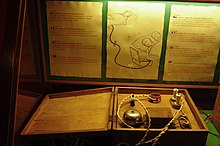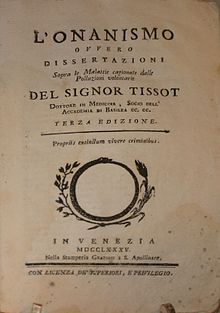Clitoridectomy or clitorectomy is the surgical removal, reduction, or partial removal of the clitoris. It is rarely used as a therapeutic medical procedure, such as when cancer has developed in or spread to the clitoris. It is often performed on intersex newborns. Commonly, non-medical removal of the clitoris is performed during female genital mutilation.
Onan was a figure detailed in the Book of Genesis chapter 38, as the second son of Judah who married the daughter of Shuah the Canaanite. Onan had an older brother Er and a younger brother, Shelah as well. After being commanded by his father, Judah, to perform his duty as a husband's brother according to the custom of levirate marriage with the late Er's wife Tamar, Onan instead refused to perform his duty as a levirate and "spilled his seed on the ground whenever he went in" because "the offspring would not be his", and was thus put to death by Yahweh. This act is detailed as retribution for being "displeasing in the sight of Lord". Onan's crime is often misinterpreted to be masturbation but it is universally agreed among biblical scholars that Onan's death is attributed to his refusal to fulfill his obligation of levirate marriage with Tamar by committing coitus interruptus.
Circumcision likely has ancient roots among several ethnic groups in sub-equatorial Africa, Egypt, and Arabia, though the specific form and extent of circumcision has varied. Ritual male circumcision is known to have been practiced by South Sea Islanders, Aboriginal peoples of Australia, Sumatrans, Incas, Aztecs, Mayans and Ancient Egyptians. Today it is still practiced by Jews, Muslims, Coptic Christians, Ethiopian Orthodox, Eritrean Orthodox, Druze, Samaritans and some tribes in East and Southern Africa, as well as in the United States, South Korea and Philippines.
Antisexualism is opposition or hostility towards sexual behavior and sexuality.

Sexuality in Islam contains a wide range of views and laws, which are largely predicated on the Quran, and the sayings attributed to Muhammad (hadith) and the rulings of religious leaders (fatwa) confining sexual activity to marital relationships between men and women. Sexual jurisprudence and marital jurisprudence are the codifications of Islamic scholarly perspectives and rulings on sexuality, which both in turn also contain components of Islamic family jurisprudence, Islamic marital jurisprudence, hygienical, criminal and bioethical jurisprudence. All instructions regarding sex in Islam are considered parts of, firstly, Taqwa or obedience and secondly, Iman or faithfulness to God. Sensitivity to gender difference and modesty outside of marriage can be seen in current prominent aspects of Muslim cultures, such as interpretations of Islamic dress and degrees of gender segregation. Islamic marital jurisprudence allows Muslim men to be married to multiple women.
Sex is considered repeatedly in the Hebrew Bible. Some references provide unambiguous ethical regulations, such as the laws given in Leviticus or Deuteronomy. Others are more ambivalent, most famously the potentially homosexual actions of Ham with his father, Noah. Its depictions of homosexuality, rape, prostitution and incest have spurred considerable academic and theological attention.

Female hysteria was once a common medical diagnosis for women. It was described as exhibiting a wide array of symptoms, including anxiety, shortness of breath, fainting, nervousness, sexual desire, insomnia, fluid retention, heaviness in the abdomen, irritability, loss of appetite for food or sex, even sexually forward behavior, and a "tendency to cause trouble for others". It is no longer recognized by medical authorities as a medical disorder. Its diagnosis and treatment were routine for hundreds of years in Western Europe.
Spermatorrhea is a condition of excessive, involuntary seminal discharge. In several cultures, this referred to ejaculation outside of certain approved sexual practices and was thus a subjective term. A more modern medical definition is the excessive release of semen with no accompanying erection or orgasm.

Sexual attitudes and behaviors in ancient Rome are indicated by art, literature, and inscriptions, and to a lesser extent by archaeological remains such as erotic artifacts and architecture. It has sometimes been assumed that "unlimited sexual license" was characteristic of ancient Rome, but sexuality was not excluded as a concern of the mos maiorum, the traditional social norms that affected public, private, and military life. Pudor, "shame, modesty", was a regulating factor in behavior, as were legal strictures on certain sexual transgressions in both the Republican and Imperial periods. The censors—public officials who determined the social rank of individuals—had the power to remove citizens from the senatorial or equestrian order for sexual misconduct, and on occasion did so. The mid-20th-century sexuality theorist Michel Foucault regarded sex throughout the Greco-Roman world as governed by restraint and the art of managing sexual pleasure.
Delayed ejaculation (DE) describes a man's inability or persistent difficulty in achieving orgasm, despite typical sexual desire and sexual stimulation. Generally, a man can reach orgasm within a few minutes of active thrusting during sexual intercourse, whereas a man with delayed ejaculation either does not have orgasms at all or cannot have an orgasm until after prolonged intercourse which might last for 30–45 minutes or more. Delayed ejaculation is closely related to anorgasmia.

Circumcision is a procedure that removes the foreskin from the human penis. In the most common form of the operation, the foreskin is extended with forceps, then a circumcision device may be placed, after which the foreskin is excised. Topical or locally injected anesthesia is generally used to reduce pain and physiologic stress. Circumcision is generally electively performed, most commonly done as a form of preventive healthcare, as a religious obligation, or as a cultural practice. It is also an option for cases of phimosis, other pathologies that do not resolve with other treatments, and chronic urinary tract infections (UTIs). The procedure is contraindicated in cases of certain genital structure abnormalities or poor general health.
Among the world's religions, views on masturbation vary widely. Some religions view it as a spiritually detrimental practice, some see it as not spiritually detrimental and others take a situational view. Among these latter religions, some view masturbation as allowable if used as a means towards sexual self-control, or as part of healthy self-exploration, but disallow it if it is done with motives they consider to be wrong, or as an addiction. For example, Christian denominations have different views on masturbation. Today, Roman Catholic, Eastern Orthodox, Oriental Orthodox and some Protestant Christians consider masturbation to be a sin. Many Protestant churches in Northern and Western Europe and some Protestant churches in Northern America and in Australia/New Zealand see masturbation as not a sin.

Samuel Auguste André David Tissot was a notable 18th-century Swiss physician.

Masturbation is a form of autoeroticism in which a person sexually stimulates their own genitals for sexual arousal or other sexual pleasure, usually to the point of orgasm. The stimulation may involve the use of hands, everyday objects, sex toys, or more rarely, the mouth. Masturbation may also be performed with a sex partner, either masturbating together or watching the other partner masturbate.
Heinrich Kaan was a 19th-century physician known for his seminal contributions to early sexology. Different sources identify him as Ruthenian or as Russian. He was the personal physician to the Czar.

Isaac Baker Brown was a prominent 19th-century English gynaecologist and obstetrical surgeon. He had a reputation as a specialist in the diseases of women and advocated certain surgical procedures, including clitoridectomies, as cures for epilepsy and hysteria. In 1867, his career ended when he was accused of performing these procedures without consent of the patients. He was subsequently expelled from the Obstetrical Society of London.
Jewish traditions across different eras and regions devote considerable attention to sexuality. Sexuality is the subject of many narratives and laws in the Tanakh and rabbinic literature.

Sexuality in South Korea has been influenced by culture, religion, and westernization. Viewpoints in contemporary society can be viewed as a conflict between the traditional, conservative older generation and the more liberal and 'modern' generation. Due to this conflict, several issues in Korea, including sexual education, homosexuality, and sexual behavior are highly contested.
The prohibition of extracting semen in vain is a Biblical prohibition derived from, this is explained in the Midrash and Talmud. The prohibition forbids a male from intentional wasteful spilling of his semen. Unintentional wasting of seed is also a (lesser) sin according to the Oral Torah.

Onania, or the Heinous Sin of Self-Pollution, and All Its Frightful Consequences, in Both Sexes, Considered, With Spiritual and Physical Advice for Those Who Have Already Injur'd Themselves by This Abominable Practice, often referred to by its shortened title: Onania: or, the heinous sin of self-pollution, or simply Onania, is a pamphlet opposing masturbation. Its date of first publication is thought to be around 1712–1716 and copies are known to have been printed in London in 1723. The identity of its author is unknown; it has been variously attributed to the English surgeon John Marten, and to a "Dr. Bekkers".











